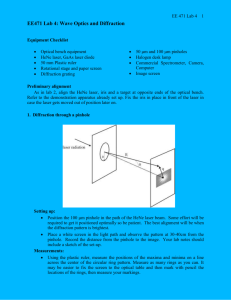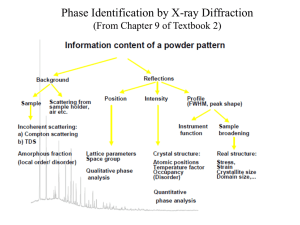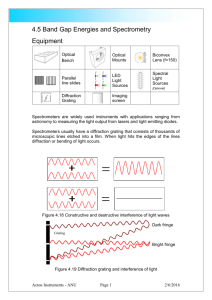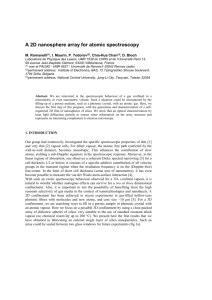Diffracted spots
advertisement
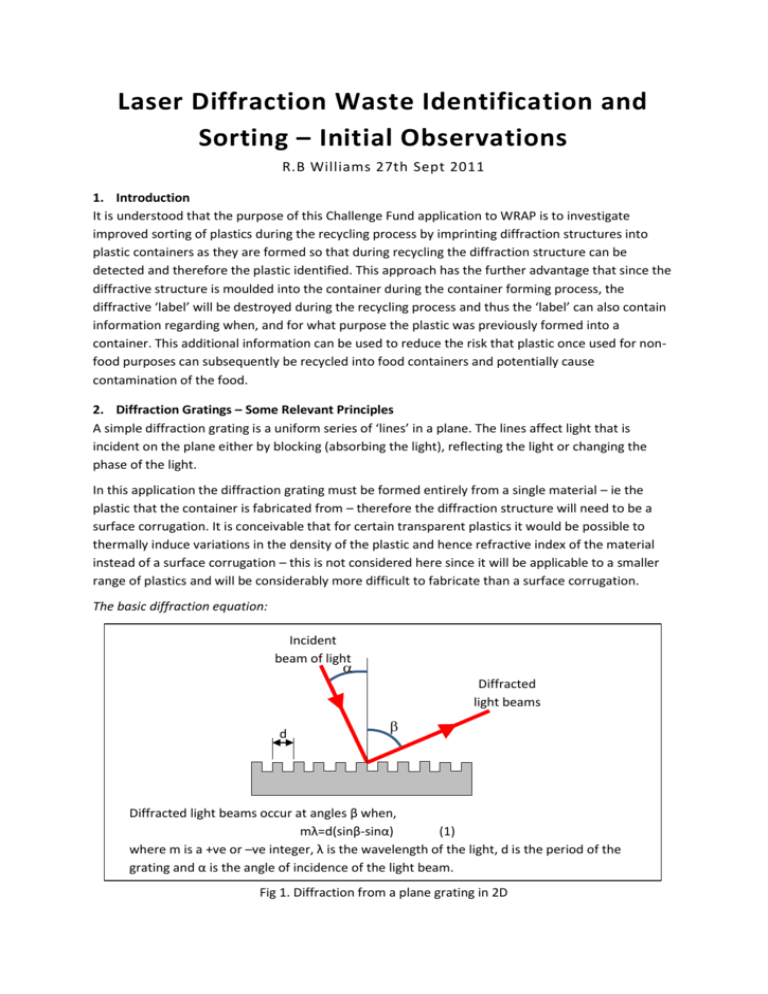
Laser Diffraction Waste Identification and Sorting – Initial Observations R.B Williams 27th Sept 2011 1. Introduction It is understood that the purpose of this Challenge Fund application to WRAP is to investigate improved sorting of plastics during the recycling process by imprinting diffraction structures into plastic containers as they are formed so that during recycling the diffraction structure can be detected and therefore the plastic identified. This approach has the further advantage that since the diffractive structure is moulded into the container during the container forming process, the diffractive ‘label’ will be destroyed during the recycling process and thus the ‘label’ can also contain information regarding when, and for what purpose the plastic was previously formed into a container. This additional information can be used to reduce the risk that plastic once used for nonfood purposes can subsequently be recycled into food containers and potentially cause contamination of the food. 2. Diffraction Gratings – Some Relevant Principles A simple diffraction grating is a uniform series of ‘lines’ in a plane. The lines affect light that is incident on the plane either by blocking (absorbing the light), reflecting the light or changing the phase of the light. In this application the diffraction grating must be formed entirely from a single material – ie the plastic that the container is fabricated from – therefore the diffraction structure will need to be a surface corrugation. It is conceivable that for certain transparent plastics it would be possible to thermally induce variations in the density of the plastic and hence refractive index of the material instead of a surface corrugation – this is not considered here since it will be applicable to a smaller range of plastics and will be considerably more difficult to fabricate than a surface corrugation. The basic diffraction equation: Incident beam of light Diffracted light beams d Diffracted light beams occur at angles β when, mλ=d(sinβ-sinα) (1) where m is a +ve or –ve integer, λ is the wavelength of the light, d is the period of the grating and α is the angle of incidence of the light beam. Fig 1. Diffraction from a plane grating in 2D The above equation deals with the ‘2 dimensional’ case – ie a planar grating where the incident light is in the plane perpendicular to the grating lines and containing the normal to the grating plane. Generalisation of this to the 3d case in which a planer grating is illuminated at any angle does not make any significant difference to the diffraction pattern. Thus we can use equation 1 to estimate the required period, d, of the diffraction grating. Equation 1 predicts that for each value of m, the diffraction grating will produce a diffracted beam at a particular angle β. Therefore what is observed when the grating is illuminated by a laser beam is many diffracted beams (orders), one for each value of m either side of the specular reflection of the incident beam (specular reflection occurs when m = 0 and so α=β). In practice only the orders corresponding to low values of m (approx. -3, -2, -1, 0, 1, 2, 3) are likely to be visible. If one considers the 3d case – ie a planar grating where the incident beam is out of the plane perpendicular to the grating lines and the normal to the plane of the grating, the result is very similar, ie a line of diffracted beams at similar angles. It is likely that this project will require more complex diffraction patterns than the simple line of beams provided by a simple planar grating of lines. For instance, if the diffractive pattern in the sample is a grid rather than an array of lines then the diffracted pattern becomes a series of beams arranged in a cross, rather that the series of beams in a single line. Any pattern of beams that is needed can be created by an appropriate diffracting pattern. To calculate what diffractive structure is required is more complex than simply using equation 1 above however it is still relatively straightforward – the structure of the diffracting pattern can be calculated simply by taking the Fourier transform of the required diffraction pattern – eg in the example above the Fourier transform of the diffracting beams (a cross shape) is indeed the diffracting pattern - a grid. The calculation of the diffracting structure can be done either ‘in house’ using commercial mathematical software such as MatLab or Mathermatica, or commercial optical design software such as ZEMAX. Alternately there are a number of small companies that commercially produce diffractive pattern generators (ie exactly what is needed to be incorporated into the plastic container) Many of these companies offer services either to fabricate custom diffractive structures, or consultancy to advise and calculate the necessary diffractive structure to produce the optical pattern required. A selection of such companies are: Holoeye - http://www.holoeye.com/diffractive_optical_elements_doe.html (Also available via UK distributor, Laser Components, www.lasercomponents.com) HoloOr, Israel – http://www.holoor.com (UK distributor, Laser Components, www.lasercomponents.com) RPC Photonics, Rochester, NY, USA - http://www.rpcphotonics.com/optical.asp Polymer optics, Wokingham - http://www.polymer-optics.co.uk MicroSystems, Warrington http://www.microsystems.uk.com/english/polymer_optics_injection_moulding.html Edinburgh Photonics Ltd - http://www.beamshaping.co.uk/ Laser Optical Engineering Ltd, Derbyshire http://www.laseroptical.co.uk/doe_products.html 3. Suitability of commercially available sorting systems Visys and Best Sorting manufacture sorting systems. From a review of both companies’ websites, it seems that both companies have the key pieces of equipment necessary for readout of diffractive patterns. Inevitably it is likely that some customisation of the sorting system and software would be needed. Both companies offer laser scanning and florescence measurement, suggesting that they have modules that provide scanning laser beams at several wavelengths. Both companies also indicate they have camera modules, which would be needed to detect the diffractive pattern. Image analysis software would be required to detect the diffraction patterns from within the images – again both companies offer customisable image processing software, possibly neural network based. 4. Potential geometries Diffraction patterns can be viewed either in transmission or reflection. Although it is more straightforward to visualise the operation of a diffraction grating in transmission, initial thoughts suggest that reflection would be a better choice. This is for several reasons: Transmission requires the plastic to be transparent – this is unlikely to be true for all desired plastics. In transmission the light has to travel from one side of the squashed container to the other. It seems that this would most likely result in the diffraction pattern needing to travel through one or more face of the container potentially with those faces of the container being crumpled. This would result in significant distortion of the diffraction pattern. In reflection it would seem that it is much less likely that this will happen. In transmission it is likely that the diffracted pattern could get blocked by labels on the back surfaces of the container before it reaches the camera on the other side of the container. One potential drawback to using reflection is the reflectivity of the surfaces of the containers – if this is not sufficient the diffracted pattern will be not be bright enough to be recorded using the camera. Some brief tests using a laser pointer and various plastic food containers found around the house suggest that there is a good likelihood that the reflectivity for most plastics will be high enough. Containers into chute Screen to view diffraction pattern Diffracted spots Camera Laser scanner Transparent wall to chute Plastic container Laser beam directed upward underneath screen Fig 2. Suggested geometry for reading out diffraction pattern A suggestion for a suitable geometry is shown in fig 2 above. Details of the sorting systems available on the market were not available for this initial report, therefore a number of assumption have been made. So as to detect the diffracted pattern, a screen is positioned a distance from the transparent wall of the chute – the diffracted beams hit the screen and form spots on the screen which can be photographed using the camera. The camera can’t directly record the diffractive beams because the camera lens will be small in comparison to the width of the chute and the diffracted beams will most likely miss the lens. The chute is assumed to be approx. 300mm wide to allow for large plastic containers such as 1 galleon cans. The laser beam from the scanner will need to hit the plastic containers behind the viewing screen. This could be achieved by directing the laser upward at an angle so that it hits the containers behind the screen and the diffracted pattern reflects upward onto the back of the screen. Image processing will be required to isolate a diffraction pattern from the images recorded by the camera. This is because the containers, and therefore the diffraction patterns will be presented at a wide variety of angles, both in the plane of the transparent wall of the chute and out of this plane. Undoubtedly there are many different possible geometries, and many issues to further overcome before the design is finalised. This hypothesis of the geometry of the system has been made for the purpose of this initial report to enable calculation of some of the key parameters that are needed at this stage to assess feasibility and enable proof of concept experiments. These parameters are calculated in the next section. 5. Key Parameters In this section, estimates of the following key parameters are calculated: The dimensions of the structures required in the diffracting pattern The wavelength of the laser Typical laser beams which can travel the distances required (up to 1m) without significant divergence are approx. 1mm in diameter. Therefore, in order for the pattern of diffracted spots to be clearly identified in the presence of the inevitable scatter and other sources of noise, it is assumed that the diffracted spots need to hit the screen approx. 5mm apart. To calculate the dimensions of the structures required to create diffraction patterns that meet this criterion, we need to make an estimate of the distance between the screen and plastic container so that we can calculate the diffraction angle needed in equation 1. Clearly this distance will be variable since the containers will be crushed and the face that the laser hits may not be in contact with the transparent wall of the chute and also may not be parallel to the chute wall. It is assumed that the depth of the chute is approx 150mm to accommodate large containers after crushing. With this assumption it is assumed that the face of the container that the laser beam hits is likely to be within approx 30mm of the wall of the chute (particularly if the chute is horizontal and the transparent wall forms the base of the chute) Should these assumptions be reasonable, it seems reasonable to assume that the screen could be 100mm from the transparent wall of the chute. This is likely to be a critical dimension since the larger this distance is, the smaller the effect of ‘misalignment’ of the container will be on the diffraction pattern. However as this distance increases the intensity of the diffracted spots reduces due to non-uniform surfaces, low reflection coefficients and scattering at rough surfaces of containers (eg milk containers). Using the assumptions above, the diffraction angle, β is given by Tanβ = 5mm/100mm. Since this is a small angle Sinβ ≈ β ≈Tanβ = 5/100. From equation 1, d=mλ/(Sinβ – Sinα) Therefore for the first diffraction order (m=1), and with an angle of incidence of the laser beam, α, of 0°, d=100λ/5=20λ. Therefore assume that the period required in the diffraction structure will be approx. 20λ In terms of the optimal wavelength of the laser, the above would suggest there is not much to be gained from choosing a particular wavelength for practical choices of lasers. For instance a 630nm diode laser would imply length scales within the diffracting structure of 20λ = 12600nm = 12μm. However if an 800nm laser was used, then the length scale would be 16μm, which in terms of fabrication in a plastic by moulding is unlikely to be significantly easier than the 12μm required for a laser of 630nm. Using lasers with a wavelength longer than 1 μm is unlikely to be economic since this would mean using expensive infrared cameras (unless these are already available in existing sorting systems). It is therefore assumed that a 630nm laser will be used due their low cost, high performance and likely availability in the existing sorting machines In summary, the likely wavelength of the laser would be approx. 630nm and length scale of the structure to be moulded into the plastic is likely to be approx. 12μm. 6. Encoding further information in the diffraction structure In section 5 above the period of a grating to produce a simple line of spots is calculated. If all that is required is to label the plastic as ‘food’ or ‘non-food’ then the simple presence or absence of this grating can achieve this. However it may prove possible to encode further information in the grating, for instance the type of plastic. The calculation in section 5 calculates the period of a simple grating to produce a simple line of spots. It is possible to produce any diffraction pattern that is desired by using a suitably chosen diffracting structure. If, for example, one is looking for say 20 distinct patterns that could easily be distinguished by image analysis software, 20 suitable patterns could be devised and the diffracting structure required to generate these 20 patterns calculated. The method to calculate the diffracting structure is to simply calculate the Fourier transform of the desired diffraction pattern. The implication of doing this is that a finer period structure will be required in the diffracting structure. To get more complex patterns than the basic array of spots, higher order periods are required in the diffracting structure – it is estimated that a factor of 10 shorter periods could be required, thus changing the requirement on the diffracting structure from 20λ to 2λ, ie 1.2μm using a 630nm laser. 7. Suggestions for equipment required for proof of concept experiments Taking the assumptions above, proof of concept experiments could be conducted using a low cost laser pointer operating around 630nm, although the wavelength seems non-critical. The camera is non-critical and can be any readily available CMOS or CCD camera. Test diffraction gratings could either be: Sections cut from a CD - brief experiments with a laser pointer show these are have a reasonably suitable diffraction angle Commercially purchased gratings such as one from Comar instruments (www.comaroptics.com), catalogue number 100DP00 priced at £20.60. This grating has 100 lines per mm and so has the basic diffraction orders at the correct angle to give a 5mm spacing of spots of the screen as in section 5. The item is designed to work in transmission but is likely to be good enough in reflection and is likely to mimic a grating in a transparent plastic. Before ordering this item the detailed specifications should be checked with Comar. Undoubtedly, there are other gratings available; however for an initial bench top experiment this is likely to be a good starting point. This starting point will enable the main issues to be identified and better determine the specifications of more realistic sample gratings.


